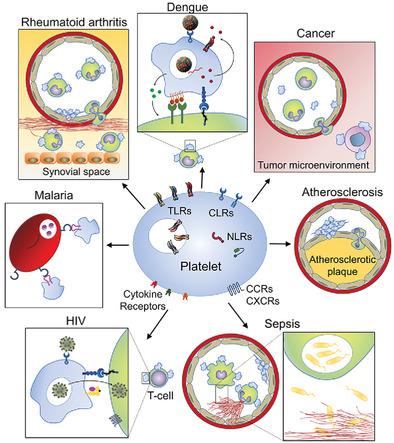当前位置:
X-MOL 学术
›
J. Leukoc. Biol.
›
论文详情
Our official English website, www.x-mol.net, welcomes your
feedback! (Note: you will need to create a separate account there.)
Innate immune receptors in platelets and platelet-leukocyte interactions.
Journal of Leukocyte Biology ( IF 3.6 ) Pub Date : 2020-08-10 , DOI: 10.1002/jlb.4mr0620-701r Paula Ribeiro Braga Dib 1, 2 , Anna Cecíllia Quirino-Teixeira 1 , Laura Botelho Merij 1 , Mariana Brandi Mendonça Pinheiro 1 , Stephane Vicente Rozini 1 , Fernanda Brandi Andrade 1 , Eugenio Damaceno Hottz 1
Journal of Leukocyte Biology ( IF 3.6 ) Pub Date : 2020-08-10 , DOI: 10.1002/jlb.4mr0620-701r Paula Ribeiro Braga Dib 1, 2 , Anna Cecíllia Quirino-Teixeira 1 , Laura Botelho Merij 1 , Mariana Brandi Mendonça Pinheiro 1 , Stephane Vicente Rozini 1 , Fernanda Brandi Andrade 1 , Eugenio Damaceno Hottz 1
Affiliation

|
Platelets are chief cells in hemostasis. Apart from their hemostatic roles, platelets are major inflammatory effector cells that can influence both innate and adaptive immune responses. Activated platelets have thromboinflammatory functions linking hemostatic and immune responses in several physiological and pathological conditions. Among many ways in which platelets exert these functions, platelet expression of pattern recognition receptors (PRRs), including TLR, Nod‐like receptor, and C‐type lectin receptor families, plays major roles in sensing and responding to pathogen‐associated or damage‐associated molecular patterns (PAMPs and DAMPs, respectively). In this review, an increasing body of evidence is compiled showing the participation of platelet innate immune receptors, including PRRs, in infectious diseases, sterile inflammation, and cancer. How platelet recognition of endogenous DAMPs participates in sterile inflammatory diseases and thrombosis is discussed. In addition, platelet recognition of both PAMPs and DAMPs initiates platelet‐mediated inflammation and vascular thrombosis in infectious diseases, including viral, bacterial, and parasite infections. The study also focuses on the involvement of innate immune receptors in platelet activation during cancer, and their contribution to tumor microenvironment development and metastasis. Finally, how innate immune receptors participate in platelet communication with leukocytes, modulating leukocyte‐mediated inflammation and immune functions, is highlighted. These cell communication processes, including platelet‐induced release of neutrophil extracellular traps, platelet Ag presentation to T‐cells and platelet modulation of monocyte cytokine secretion are discussed in the context of infectious and sterile diseases of major concern in human health, including cardiovascular diseases, dengue, HIV infection, sepsis, and cancer.
中文翻译:

血小板和血小板-白细胞相互作用中的先天免疫受体。
血小板是止血中的主要细胞。除了其止血作用外,血小板是主要的炎症效应细胞,可以影响先天和适应性免疫应答。活化的血小板具有血栓发炎功能,可在几种生理和病理条件下将止血和免疫反应联系起来。在血小板发挥这些功能的许多方式中,包括TLR,Nod样受体和C型凝集素受体家族在内的模式识别受体(PRR)的血小板表达在感知和响应病原体相关或损伤的过程中起着重要作用。相关分子模式(分别为PAMP和DAMP)。在本综述中,越来越多的证据表明,血小板固有免疫受体(包括PRR)参与了传染病,无菌性炎症和癌症。讨论了内源性DAMPs的血小板识别如何参与无菌炎性疾病和血栓形成。此外,血小板对PAMPs和DAMPs的识别会在传染性疾病(包括病毒,细菌和寄生虫感染)中引发血小板介导的炎症和血管血栓形成。这项研究还着重于先天免疫受体与癌症期间血小板活化的关系,以及它们对肿瘤微环境发展和转移的贡献。最后,突出了先天免疫受体如何参与与白细胞的血小板通讯,调节白细胞介导的炎症和免疫功能。这些细胞通讯过程,包括血小板诱导的嗜中性粒细胞胞外陷阱的释放,
更新日期:2020-09-30
中文翻译:

血小板和血小板-白细胞相互作用中的先天免疫受体。
血小板是止血中的主要细胞。除了其止血作用外,血小板是主要的炎症效应细胞,可以影响先天和适应性免疫应答。活化的血小板具有血栓发炎功能,可在几种生理和病理条件下将止血和免疫反应联系起来。在血小板发挥这些功能的许多方式中,包括TLR,Nod样受体和C型凝集素受体家族在内的模式识别受体(PRR)的血小板表达在感知和响应病原体相关或损伤的过程中起着重要作用。相关分子模式(分别为PAMP和DAMP)。在本综述中,越来越多的证据表明,血小板固有免疫受体(包括PRR)参与了传染病,无菌性炎症和癌症。讨论了内源性DAMPs的血小板识别如何参与无菌炎性疾病和血栓形成。此外,血小板对PAMPs和DAMPs的识别会在传染性疾病(包括病毒,细菌和寄生虫感染)中引发血小板介导的炎症和血管血栓形成。这项研究还着重于先天免疫受体与癌症期间血小板活化的关系,以及它们对肿瘤微环境发展和转移的贡献。最后,突出了先天免疫受体如何参与与白细胞的血小板通讯,调节白细胞介导的炎症和免疫功能。这些细胞通讯过程,包括血小板诱导的嗜中性粒细胞胞外陷阱的释放,











































 京公网安备 11010802027423号
京公网安备 11010802027423号